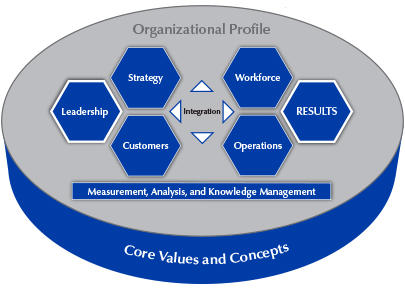Blogrige
The Official Baldrige Blog

Baldrige framework diagram
I recently had a conversation with some of the Baldrige Program staff about the new Baldrige Framework diagram issued in 2015, and sometimes referred to as the "Baldrige Hockey Puck." The conversation reminded me how much symbolism is built into the diagram and that this symbolism may be obvious only to the creators. So this posting is my take on the meaning of this diagram, depicting the components of a well-designed organizational performance management system.
I will start with the base of the hockey puck. It comprises the Baldrige Core Values and Concepts (core values). These eleven core values are the beliefs embedded in the Baldrige Criteria for Performance Excellence. They are the underpinnings of the Criteria. It is not intended that these core values be adopted as the core values of organizations using the Criteria, but that they be beliefs the organization can ascribe to as a basis for their organizational performance management system.
The background for the organizational performance management system is the Organizational Profile. It is always present as a key influencer of your performance management system. All responses to Items in the Criteria should be responsive to the specific factors that govern your organizational environment, key relationships, competitive environment, and strategic context as described in your Organizational Profile. We talk about using this Profile to "load your lenses." You should see your organization through the lenses provided by this information, that defines who you are as an organization.
Leadership, Strategy, and Customers are categories 1, 2, and 3, respectively, of the Baldrige Criteria. They are shown as adjoining, interlocking hexagons because we believe leadership sets the tone and vision for the organization and this includes leading strategic thinking and a focus on the customers of the organization. If leadership is not focused on strategy and customers, the organization is not likely to be either. These are key contributors to the organization's ongoing success. Therefore, we refer to these three categories as the leadership triad.
Workforce, Operations, and Results are categories 5, 6, and 7, respectively, of the Baldrige Criteria. They are shown as adjoining, interlocking hexagons because we believe the results the organization achieves are the outcome of the people (workforce) and processes (operations) that produce the organization's goods and services, implement the organization's strategy, and serve its customers. Therefore, we refer to these three categories as the results triad.
Measurement, Analysis, and Knowledge Management is category 4 of the Baldrige Criteria. It is shown as a rectangle that supports and serves as the foundation of the organization's performance management system. Category 4 provides the fact base that allows for data- and knowledge-driven decision making in the organization. Measurement, analysis, and knowledge enable all the other functions in the organization (categories 1-6) to deliver successful outcomes (category 7).
The hexagons for the Leadership and Results categories are framed in white to call heightened attention to these two categories and to indicate (see the horizontal arrowheads) the clear relationship between leadership and the results the organization achieves. If Leadership isn't focused on all key results for the organization (not just financials), the organization is not likely to have ongoing success. And Results must feed back to Leaders key information that they will use in guiding and steering the organization. The importance of these two categories is further emphasized in the Baldrige Scoring System, where they have more points assigned than any of the other categories. Furthermore RESULTS is shown in capital letters because this category alone is assigned 450 out of the 1000 possible points in the scoring system. The organization's performance management system must be focused on achievement (results) to drive ongoing success.
The four arrowheads with the word Integration in the center depict that the questions in the criteria force systems thinking and emphasize the interdependencies that make a performance system rather than simply a set of building blocks. The arrowheads also point to the Organizational Profile and category 4 to again indicate that the system is dependent on who you are as an organization and that a systems approach is fact-based, relying on a foundation of Measurement, Analysis, and Knowledge Management.
So, in this case, a picture is worth almost a thousand words!
About the author
Related Posts
Comments
- Reply





